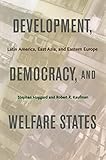Development, Democracy, and Welfare States : Latin America, East Asia, and Eastern Europe / Robert R. Kaufman, Stephan Haggard.
Material type: TextPublisher: Princeton, NJ : Princeton University Press, [2020]Copyright date: ©2009Description: 1 online resource (496 p.) : 34 line illus. 54 tablesContent type:
TextPublisher: Princeton, NJ : Princeton University Press, [2020]Copyright date: ©2009Description: 1 online resource (496 p.) : 34 line illus. 54 tablesContent type: - 9780691135953
- 9780691214153
- Welfare state -- East Asia
- Welfare state -- Europe, Eastern
- Welfare state -- Latin America
- POLITICAL SCIENCE / Public Policy / Social Services & Welfare
- Allende, Salvador
- Aquino, Corazon
- Argentina
- Bautista, Victoria A
- Brazil
- Brooks, Sarah
- Castiglioni, Rossana
- Estrada, Joseph
- Fujimori, Alberto
- Gierek, Edward
- Hwang, Gyu-Jin
- Japan
- Kaser, Michael
- Lee Kuan Yew
- Marcos, Ferdinand
- Mesa-Lago, Carmelo
- NGOs
- Orenstein, Mitchell A
- Peronists
- Ramos, Fidel
- Roberts, Kenneth
- Soviet Union
- Taiwan
- Vanhuysse, Pieter
- Wong, Joseph
- cross-class coalition
- democracy
- economic openness
- health system
- labor
- path dependence
- political realignments
- 330.12/6 22
- online - DeGruyter
- Issued also in print.
| Item type | Current library | Call number | URL | Status | Notes | Barcode | |
|---|---|---|---|---|---|---|---|
 eBook
eBook
|
Biblioteca "Angelicum" Pont. Univ. S.Tommaso d'Aquino Nuvola online | online - DeGruyter (Browse shelf(Opens below)) | Online access | Not for loan (Accesso limitato) | Accesso per gli utenti autorizzati / Access for authorized users | (dgr)9780691214153 |
Browsing Biblioteca "Angelicum" Pont. Univ. S.Tommaso d'Aquino shelves, Shelving location: Nuvola online Close shelf browser (Hides shelf browser)
Frontmatter -- Contents -- List of Figures -- List of Tables -- Preface and Acknowledgments -- Abbreviations -- INTRODUCTION. Toward a Political Economy of Social Policy -- PART ONE: The Historical Origins of Welfare Systems, 1945-80 -- CHAPTER ONE. Social Policy in Latin America, East Asia, and Eastern Europe, 1945-80: An Overview -- CHAPTER TWO. The Expansion of Welfare Commitments in Latin America, 1945-80 -- CHAPTER THREE. The Evolution of Social Contracts in East Asia, 1950-80 -- CHAPTER FOUR. Building the Socialist Welfare State: The Expansion of Welfare Commitments in Eastern Europe -- PART TWO: Democratization, Economic Crisis, and Welfare Reform, 1980-2005 -- CHAPTER FIVE. The Political Economy of Welfare Reform -- CHAPTER SIX. Democracy, Growth, and the Evolution of Social Contracts in East Asia, 1980-2005 -- CHAPTER SEVEN. Democracy, Economic Crisis, and Social Policy in Latin America, 1980-2005 -- CHAPTER EIGHT. The Legacy of the Socialist Welfare State, 1990-2005 -- CONCLUSION. Latin America, East Asia, Eastern Europe, and the Theory of the Welfare State -- APPENDIX ONE. Cross-National Empirical Studies of the Effects of Democracy on Social Policy and Social Outcomes -- APPENDIX TWO. Fiscal Federalism and Social Spending in Latin America, East Asia, and Eastern Europe -- APPENDIX THREE. A Cross-Section Model of Social Policy and Outcomes in Middle-Income Countries, 1973-80 -- APPENDIX FOUR. Regime-Coding Rules -- APPENDIX FIVE. A Cross-Section, Time-Series Model of Social Spending in Latin America, East Asia, and Eastern Europe, 1980-2000 -- APPENDIX SIX. Social Security, Health, and Education Expenditure in East Asia, Latin America, and Eastern Europe, 1980-2005 -- References -- Index
restricted access online access with authorization star
http://purl.org/coar/access_right/c_16ec
This is the first book to compare the distinctive welfare states of Latin America, East Asia, and Eastern Europe. Stephan Haggard and Robert Kaufman trace the historical origins of social policy in these regions to crucial political changes in the mid-twentieth century, and show how the legacies of these early choices are influencing welfare reform following democratization and globalization. After World War II, communist regimes in Eastern Europe adopted wide-ranging socialist entitlements while conservative dictatorships in East Asia sharply limited social security but invested in education. In Latin America, where welfare systems were instituted earlier, unequal social-security systems favored formal sector workers and the middle class. Haggard and Kaufman compare the different welfare paths of the countries in these regions following democratization and the move toward more open economies. Although these transformations generated pressure to reform existing welfare systems, economic performance and welfare legacies exerted a more profound influence. The authors show how exclusionary welfare systems and economic crisis in Latin America created incentives to adopt liberal social-policy reforms, while social entitlements from the communist era limited the scope of liberal reforms in the new democracies of Eastern Europe. In East Asia, high growth and permissive fiscal conditions provided opportunities to broaden social entitlements in the new democracies. This book highlights the importance of placing the contemporary effects of democratization and globalization into a broader historical context.
Issued also in print.
Mode of access: Internet via World Wide Web.
In English.
Description based on online resource; title from PDF title page (publisher's Web site, viewed 02. Feb 2021)









